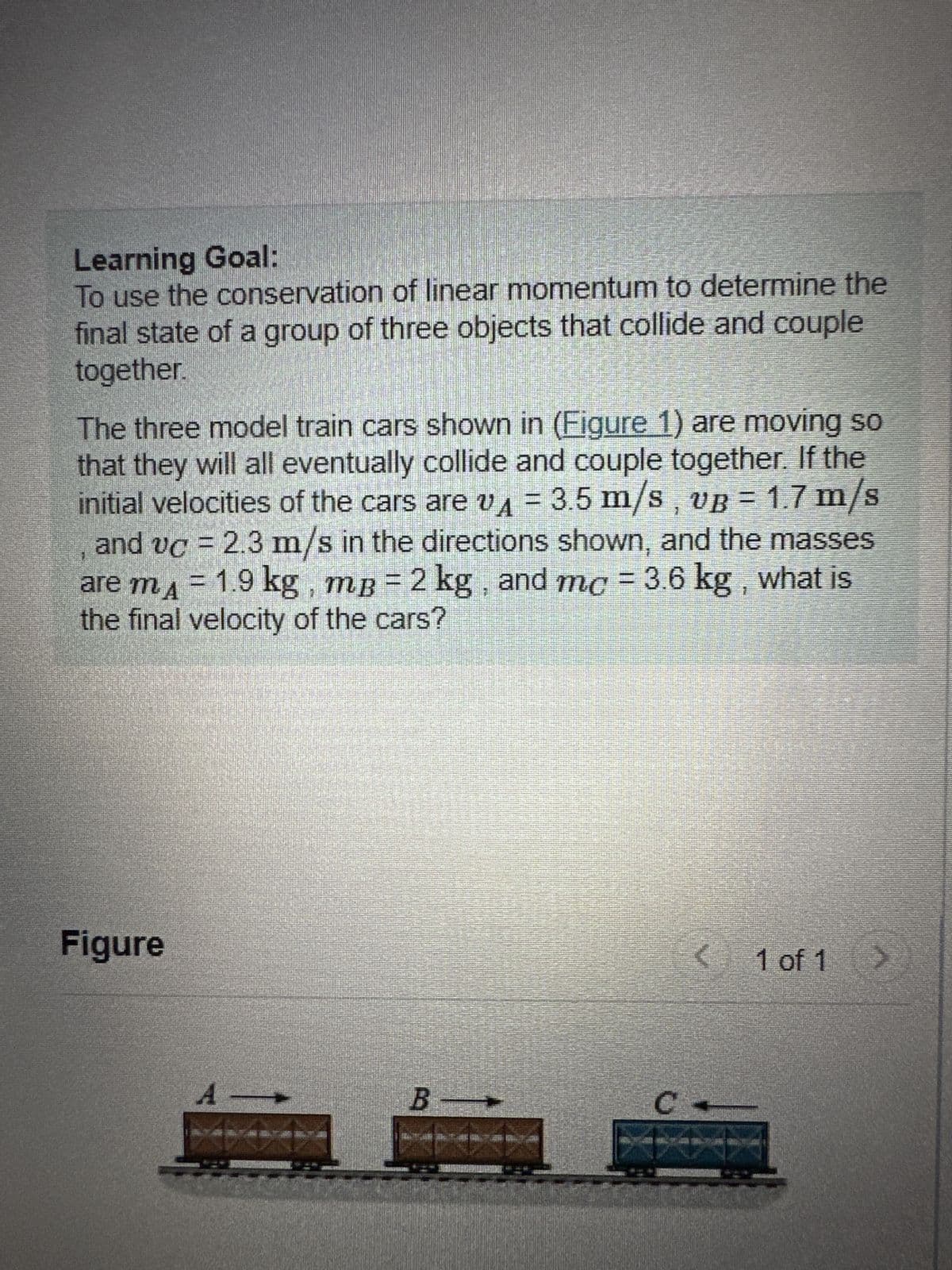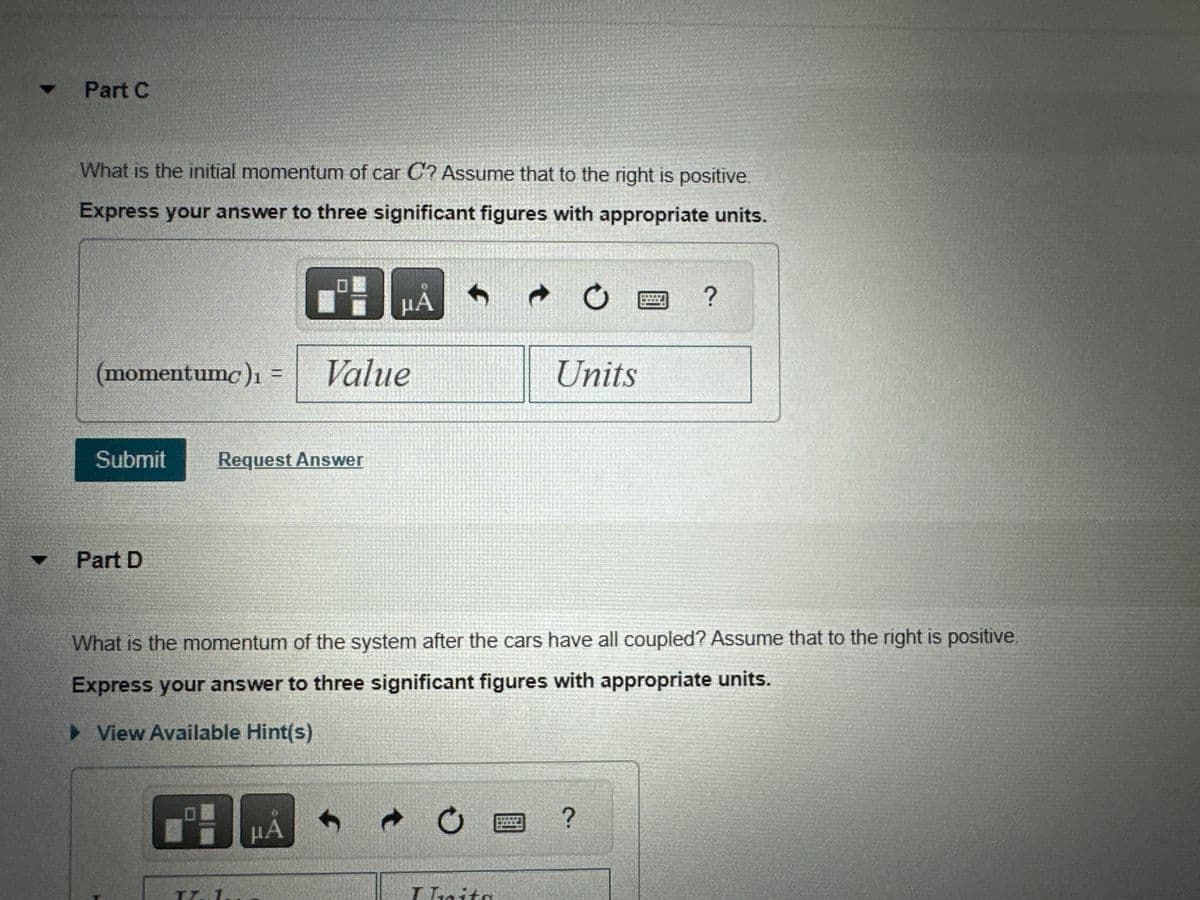Learning Goal: To use the conservation of linear momentum to determine the final state of a group of three objects that collide and couple together. The three model train cars shown in (Figure 1) are moving so that they will all eventually collide and couple together. If the initial velocities of the cars are v = 3.5 m/s, vB = 1.7 m/s and vc = 2.3 m/s in the directions shown, and the masses are m₁ = 1.9 kg, mB = 2 kg, and mc = 3.6 kg, what is the final velocity of the cars? Figure B < 1 of 1
Learning Goal: To use the conservation of linear momentum to determine the final state of a group of three objects that collide and couple together. The three model train cars shown in (Figure 1) are moving so that they will all eventually collide and couple together. If the initial velocities of the cars are v = 3.5 m/s, vB = 1.7 m/s and vc = 2.3 m/s in the directions shown, and the masses are m₁ = 1.9 kg, mB = 2 kg, and mc = 3.6 kg, what is the final velocity of the cars? Figure B < 1 of 1
Elements Of Electromagnetics
7th Edition
ISBN:9780190698614
Author:Sadiku, Matthew N. O.
Publisher:Sadiku, Matthew N. O.
ChapterMA: Math Assessment
Section: Chapter Questions
Problem 1.1MA
Related questions
Question
C and D please

Transcribed Image Text:Learning Goal:
To use the conservation of linear momentum to determine the
final state of a group of three objects that collide and couple
together.
The three model train cars shown in (Figure 1) are moving so
that they will all eventually collide and couple together. If the
initial velocities of the cars are vA = 3.5 m/s, vB = 1.7 m/s
and vc = 2.3 m/s in the directions shown, and the masses
are m₁ = 1.9 kg, mß = 2 kg, and mc = 3.6 kg, what is
the final velocity of the cars?
Figure
A
B
C
ANCIEM!
< 1 of 1
>

Transcribed Image Text:Learning Goal:
To use the conservation of linear momentum to determine the
final state of a group of three objects that collide and couple
together.
The three model train cars shown in (Figure 1) are moving so
that they will all eventually collide and couple together. If the
initial velocities of the cars are vA = 3.5 m/s, vB = 1.7 m/s
and vc = 2.3 m/s in the directions shown, and the masses
are m₁ = 1.9 kg, mß = 2 kg, and mc = 3.6 kg, what is
the final velocity of the cars?
Figure
A
B
C
ANCIEM!
< 1 of 1
>
Expert Solution
This question has been solved!
Explore an expertly crafted, step-by-step solution for a thorough understanding of key concepts.
This is a popular solution!
Trending now
This is a popular solution!
Step by step
Solved in 5 steps

Knowledge Booster
Learn more about
Need a deep-dive on the concept behind this application? Look no further. Learn more about this topic, mechanical-engineering and related others by exploring similar questions and additional content below.Recommended textbooks for you

Elements Of Electromagnetics
Mechanical Engineering
ISBN:
9780190698614
Author:
Sadiku, Matthew N. O.
Publisher:
Oxford University Press

Mechanics of Materials (10th Edition)
Mechanical Engineering
ISBN:
9780134319650
Author:
Russell C. Hibbeler
Publisher:
PEARSON

Thermodynamics: An Engineering Approach
Mechanical Engineering
ISBN:
9781259822674
Author:
Yunus A. Cengel Dr., Michael A. Boles
Publisher:
McGraw-Hill Education

Elements Of Electromagnetics
Mechanical Engineering
ISBN:
9780190698614
Author:
Sadiku, Matthew N. O.
Publisher:
Oxford University Press

Mechanics of Materials (10th Edition)
Mechanical Engineering
ISBN:
9780134319650
Author:
Russell C. Hibbeler
Publisher:
PEARSON

Thermodynamics: An Engineering Approach
Mechanical Engineering
ISBN:
9781259822674
Author:
Yunus A. Cengel Dr., Michael A. Boles
Publisher:
McGraw-Hill Education

Control Systems Engineering
Mechanical Engineering
ISBN:
9781118170519
Author:
Norman S. Nise
Publisher:
WILEY

Mechanics of Materials (MindTap Course List)
Mechanical Engineering
ISBN:
9781337093347
Author:
Barry J. Goodno, James M. Gere
Publisher:
Cengage Learning

Engineering Mechanics: Statics
Mechanical Engineering
ISBN:
9781118807330
Author:
James L. Meriam, L. G. Kraige, J. N. Bolton
Publisher:
WILEY